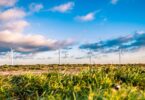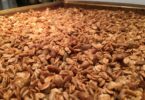Mike Annunziata is a firm believer in two things: Reducing refrigeration will help a lot of the world’s problems, and french fries can help get there.
His problem with refrigeration is largely environmental. It eats up about 15% of all of the world’s energy consumption, Annunziata said, quoting research published in Food Research International in 2010.
The food sector accounts for about 30% of the world’s total energy consumption and around 22% of all greenhouse gas emissions, according to the Food and Agriculture Organization of the United Nations. And when the electricity for refrigeration, the manufacture of that refrigeration equipment and greenhouse gases produced by lost refrigerants are taken into consideration, refrigerated storage can account for 10% of a product’s carbon footprint, according to statistics from the Global Cold Chain Alliance.
“It’s crazy if you think about it,” Annunziata said. “We have refrigerators or freezers in every home. Frozen refrigerated trucks moving food all around the world. Storage warehouses keeping food refrigerated or frozen to have higher quality [and be] more convenient.”
Annunziata sees two potential solutions to this problem: Either make refrigeration more efficient or reduce the need for refrigeration. He’s chosen the latter, and is using the technology of supercritical fluids to make ordinarily frozen food shelf-stable with his company Farther Farms.
At its facility in the former Eastman Kodak campus in Rochester, New York, Farther Farms makes fresh potatoes into fries, treats them with supercritical carbon dioxide, and packages them. The packages can travel wherever they need to go without refrigeration, and the fries are ready for the fryer.
Before a virtual tour of Farther Farms’ first-in-the-world facility, Annunziata, co-founder and CEO, said that the company’s ultimate goal is to cut down on the amount of food that needs to be refrigerated and frozen. It’s not about disrupting french fries. Farther Farms wants to change the way the world thinks about food.
“It’s not going to happen overnight, but you start with a concept that people can understand,” Annunziata said. “Everybody knows a frozen french fry. Now, they’re going to know a fry that isn’t frozen, and we can bring a product lens to that and say, ‘Here’s a high-quality shelf-stable fry.’ ”
Weak links in the cold chain
There’s more than just the environmental cost of the cold chain. It also can have an extremely high monetary cost, which is something Farther Farms co-founder and Chief Technology Officer Vipul Saran knows well.
Saran is from India, where his family is in the agriculture and food processing business. He said the biggest challenges they faced were the logistical issues and cost limitations for shipping products that required freezing or refrigeration in the subcontinent. He went to Cornell University to study food tech.
“Those basic challenges were one of the drivers for me to come to Cornell: to look for technology in some form or fashion that could be a plug-and-play [solution] for reducing the dependency on refrigeration and freezing in some manner,” Saran said.
Farther Farms CEO Mike Annunziata gestures toward the potato sorting equipment.
Permission granted by Kyle Kapustka
While taking classes in Cornell University’s business school, Saran met Annunziata, who had previously worked in the investment world. Annunziata remembers Saran getting up in front of a class and quantifying the problem he wanted to solve. In India, it cost $3,000 to ship something that needed to be in the cold chain. Something that was shelf stable only cost $90 to ship.
The desire to solve this problem sparked the idea for Farther Farms, which Annunziata and Saran started at Cornell in 2016. The business began in Cornell’s eLab Student Accelerator, then received local business grant funding to keep going. To date, Annunziata said, the company has raised about $10 million.
The company moved into its current home — about 30,000 square feet of a building where Kodak used to make touchscreen technology — last year. The building Farther Farms chose is in an industrial park that already had a lot of the needed infrastructure in place. But there was still significant work required to bring in the right kind of equipment and to make the facility comply with federal food safety regulations. The build out finished in April 2020 — on schedule, despite the onset of pandemic-related shutdowns just weeks earlier — and the company shipped out its first french fries in January.
Farther Farms is just getting started now. Annunziata wouldn’t say how many pounds of french fries the company produces, but it makes a couple of pallets of product a week. There’s a handful of foodservice customers for the fries; Annunziata said that Farther Farms is working to slowly and deliberately scale up its processes to ensure the technology works well and the product is high quality. While the fries currently are only consumed at some New York locations, Annunziata said that product will make a much farther journey as the company grows.
The right tech is supercritical
The way that Farther Farms makes its fries fresh and shelf stable is not a new technology or idea. The company uses supercritical carbon dioxide, which can be produced by pressurizing and heating the gas. When carbon dioxide reaches supercritical status, it exists as both a liquid and a gas at the same time. The existence of supercritical fluids has been known since 1822, and research on supercritical carbon dioxide dates back 90 years.
To Annunziata and Saran’s knowledge, Farther Farms is the only food company using supercritical carbon dioxide in food preservation right now. Saran said he stumbled upon its food application while researching different preservation methods. Cornell University gave Saran access to its experts and to some of its research around uses of supercritical carbon dioxide in food. Supercritical carbon dioxide has a wide array of uses now, including power generation, dyeing fabrics without water, sterilization in a biomedical context and decaffeinating coffee.
The biomedical applications caught Saran’s eye because the supercritical carbon dioxide can inactivate both what he calls “pathogens of concern” and some undesirable natural enzymatic processes. Soon after cutting an apple or potato, it will begin to brown as a part of natural chemistry. But that doesn’t happen with a potato treated with supercritical carbon dioxide.
“It’s not going to happen overnight, but you start with a concept that people can understand. Everybody knows a frozen french fry. Now, they’re going to know a fry that isn’t frozen, and we can bring a product lens to that and say, ‘Here’s a high-quality shelf-stable fry.’ ”

Mike Annunziata
Co-founder and CEO, Farther Farms
“Doing the very early stage unit cost analysis and understanding how the process would scale compared to other technologies, it sort of felt, and became clearer as we went along, that A, it is technically more advanced in terms of its capabilities against other technologies, and B, it does definitely have a bigger potential in terms of scalability,” Saran said.
Using supercritical carbon dioxide has one other very important benefit: The french fries are structurally the same. Many other shelf-stable preservation methods today, including canning and retort technology, rely on high heat cooking or high pressure. While these methods are good at preserving food, they cannot be used to preserve the fresh taste or cut structure of french fries. Annunziata pointed out that if Farther Farms used retort technology, it would be making mashed potatoes.
At Farther Farms’ facility, many of the work areas look like a traditional french fry factory. It’s much smaller, given the company’s current scale, but the processes are basically the same.
Annunziata stood in front of a massive mound of russet potatoes, which had been delivered the day before from a Maine farm. The potatoes went up a rolling conveyor belt where workers checked them for quality, removing any rotten ones or rocks. The conveyor belt continued, and a machine peeled and cut the potatoes into shoestring slices. They ran through a blancher, quickly cooking in hot water to stop the browning process.

The potato cutting area at Farther Farms’ factory.
Permission granted by Kyle Kapustka
After blanching, the potato slices roll through ovens to be dried. This is the first big difference between Farther Farms’ process and a conventional french fry factory, which would be oiling and frying the potatoes at this point. As a startup, Annunziata said Farther Farms used what equipment it could find to see if it could do the job. Those drying ovens, he pointed out, are repurposed commercial pizza ovens.
The french fries go through a quality check, and then are weighed and packaged into special five-pound bags that are sealed in the factory. They are not opened again until the fries are at their destination and ready to be cooked. The bags are loaded onto a custom-designed cart, which then gets wheeled into the massive supercritical carbon dioxide vessel, which is supplied by a five-story carbon dioxide tank outside of the building. The fries are treated in the vessel for 30 to 60 minutes, workers examine and label the bags, and then they’re done.
Annunziata touched a clear package filled with Farther Farms’ fries.
“What we’re aiming for here is this kind of semi-vacuum-pack product, kind of looking like regular french fries,” he said. “Open them up, drop them in the fryer and you’re good to go.”
A tasty sustainability story
One place where consumers can try Farther Farms fries is at Pomodori, a dining option in the student union at the State University of New York Cortland campus. Jeff Scott, director of dining services at the campus, said that he is always looking for locally made food items — but with global tastes and inspiration — to bring to campus.
Scott described the product as high-quality, natural cut fries, and said they’re very popular with students. Demand for french fries at the Pomodori station, which specializes in Italian food and subs, is up 20% compared to this same time in the 2019 school year.
And that’s without most students being aware of the Farther Farms story. Scott said that the university provides space for local food suppliers to tell their stories — through storyboards in the student union or with prominent information on the website. Farther Farms representatives came to campus in mid-September to talk about their fries and their broader sustainability and access mission. Scott said this really resonated with the university community, which tends to be much more interested in products that prioritize sustainability.

Farther Farms french fries go into a fryer.
Courtesy of Farther Farms
Scott said today’s college students tend to have eaten restaurant-quality food for their entire lives, so there’s a high bar to satisfy them in the dining hall.
“It’s got to be top quality, ultimately, I think, for it to take off,” Scott said. “…Not to minimize at all the sustainable mission of this product and this company. I think when you can put those two together, it’s just a great, great scenario.”
Ghislaine Joly, Farther Farms’ vice president of product development and innovation, joined the company over the summer. She most recently was the lead principal development scientist at french fry giant Lamb Weston, where she was the lead principal development scientist. She has more than 25 years of experience with french fries, and met the Farther Farms team through doing consulting work.
Joly evaluates the fries for their appearance, color, texture and crispness. She said Farther Farms is doing well on all of those aspects.
“It’s almost mind boggling because in general, the consumers don’t see as much differences as we can,” she said. “… As scientists, we’re trying to understand the mechanisms of production and how the process impacts the product.”
The biggest problem for Farther Farms’ fries, Joly said, is one that every manufacturer in the space is trying to solve: how to keep them crisp and tasty after they have been cooked.
Next stop: Quality food, accessible everywhere
Farther Farms is working to make its name as a CPG company, but Annunziata said it doesn’t just want to be known for french fries.
There are longer-term plans for Farther Farms to create shelf-stable fresh dips, like salsa, he said. And maybe, more down the road, shelf-stable meat products.
“It really comes down to quality food, accessible everywhere,” Annunziata said, repeating Farther Farms’ mission statement. “That’s the goal, and the shift off the cold chain is almost a byproduct of success in that goal.”
Right now, the focus is on improving Farther Farms’ french fries and more widely introducing them in foodservice. Annunziata said he’s hoping to follow in the footsteps of Impossible Foods, which started its segment-shifting Impossible Burger only in foodservice, slowly rolling it out to restaurants across the United States until it became a household name that easily translated to grocery store sales. If consumers can associate Farther Farms with quality food, he said, they will discover the rest of the story and become fans of the brand. And through the branding, the company will capture its value.
Annunziata said this philosophy is encapsulated in a saying on a wall in the office attributed to former Lamb Weston president Bobby Horowitz, who was an adviser to Farther Farms before he died last year: Strive not to be a success, but rather to be of value. If the brand is successful, Annunziata said, it will become valuable to consumers.

Farther Farms’ fries get packaged before being treated with supercritical carbon dioxide.
Permission granted by Kyle Kapustka
But there still are some issues to deal with to make Farther Farms a beloved brand. First, its products need to be at a price consumers will pay. Right now, Farther Farms’ fries are priced competitively with frozen ones, Annunziata said. However, the company wants to make sure it is getting enough money to capture the value of the product. It may price the fries at a premium in the future because of the process.
There’s also the issue of U.S. consumers’ obsession with refrigeration and freshness. In other countries, shelf-stable milk — especially in the plant-based sector — is standard. In the United States, companies had to make refrigerated versions so that consumers would trust their freshness. Annunziata believes consumers will accept shelf-stable products eventually. If they get to know Farther Farms in foodservice, he said, they will recognize the branding in the grocery store and pick up the package, even if it isn’t in the freezer case.
“It really comes down to quality food, accessible everywhere. That’s the goal, and the shift off the cold chain is almost a byproduct of success in that goal.”

Mike Annunziata
Co-founder and CEO, Farther Farms
Max Richman, Farther Farms’ vice president of business development, said that the technology also has truly international possibilities. The market for these products is anywhere in the globe, including places that don’t have access to refrigeration because they are remote or have unstable supplies of electricity.
Annunziata said the key to long-term success is changing the conversation. Nobody is talking about the sustainability challenges of the cold chain, but maybe they should. Looking at the numbers, with the supply chain snarls of 2021, the cost of cold chain shipping is up about 20% year over year, he said.
The big plant-based meat companies created products that were so good, consumers didn’t mind switching to them because they didn’t feel that they were sacrificing to make a more sustainable choice, Annunziata said. And once it was clear that pioneers like Beyond Meat and Impossible Foods could sustain consumer interest and generate a following, many other companies followed in their footsteps. The same change can start with Farther Farms and more shelf-stable food, he said.
“Hey, we’re not the only ones that I think is going to be needed to make this kind of big change,” Annunziata said. “But if we can catalyze it with our product and have a whole series of them… , then I think we can be the ones that lead that charge, as we think about using the cold chain less and less, versus right now [where] the default is everybody wants to freeze their food products.”








